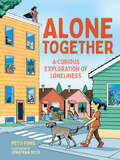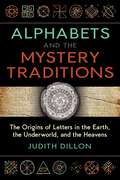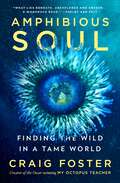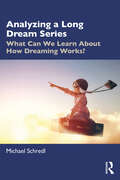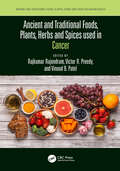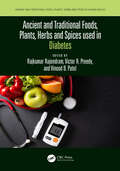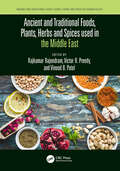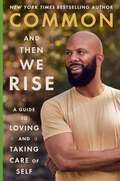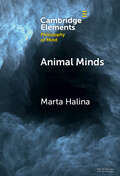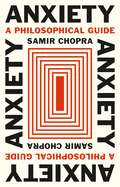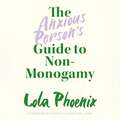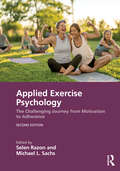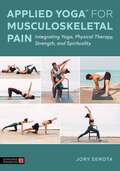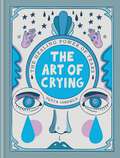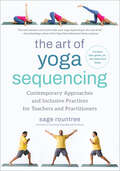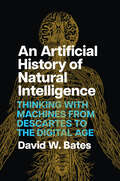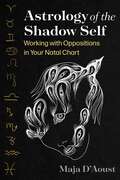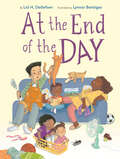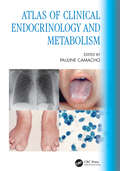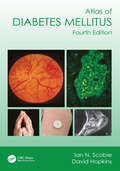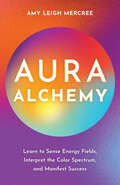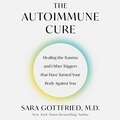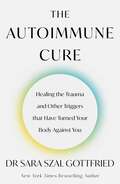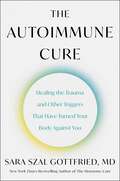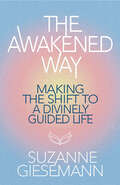- Table View
- List View
Alone Together: A Curious Exploration of Loneliness (Orca Think #12)
by Petti FongThe world is facing an epidemic of loneliness. The COVID-19 pandemic taught us new words, like isolation, quarantine and social distancing. In places like the UK and Japan, governments have appointed ministers of loneliness to examine the problem and find ways to help their citizens. What does it mean to be lonely, and what can we do about it? Alone Together explores what superheroes can teach us about being alone, the ways kids have survived on their own and how activists in the civil rights movement took a stand against loneliness. Discover what comfort foods, sweatpants and being kind to each other have to do with loneliness. Based on the podcast of the same name. Readers will learn about loneliness and how being alone can ultimately bring us closer together.
Alphabets and the Mystery Traditions: The Origins of Letters in the Earth, the Underworld, and the Heavens
by Judith DillonReveals the esoteric mysteries encoded in the order of the alphabet• Explores the secrets hidden in our alphabet and how each letter represented a specific stage on the alchemical path toward enlightenment• Divides our alphabet&’s sequence of letters into three distinct parts: the first representing Earth and the natural year, the second the Underworld and the hero&’s journey, and the third the Heavens and astronomical cycles• Reveals how the ancient secrets encoded in the numerical order of the alphabet can be found in Mystery Traditions and divination systems throughout the worldOur alphabet hides a Mystery older than its magic of turning sound into shapes. Secrets lie in the choice of objects chosen to represent early alphabet letters and their order, a pattern inherited by numerous traditions, an alchemical spell to return the sun from the dark and guide the soul toward enlightenment.Revealing the spell hidden in our alphabet, Judith Dillon explores the importance of the placement of each letter in early alphabets and how each letter represented a specific step on the alchemical path of self-transformation. She investigates the alphabet&’s spread around the world, beginning in Egypt and then spreading through Hebrew, Greek, and other ancient systems of writing and divination. These include Germanic Runes, Celtic Oghams, Tarot cards, the I Ching, and the wisdom of Mother Goose. Comparing the mythic attributes of many traditions, the author reveals the commonality of a numerical placement of symbols and how the hidden message was adapted by multiple peoples using objects and shapes from their own traditions.Examining the esoteric wisdom encoded in the alphabet, Dillon divides the numerical sequence of letters into three distinct parts. The first family of letters represents the Earth and describes the cycle of the natural year. The second family represents the Underworld and symbolizes the hero&’s journey through judgments and death into the light of day. The third represents the Heavens and its astronomical cycles. Together, our alphabet symbols are a spell of alchemical stages on a path toward the light. Hidden in plain sight, our alphabet represents a transmission of ancient wisdom, the great alchemical Mystery of transforming dark earth into shining gold, of releasing the soul from the bonds of matter into the gold of enlightenment.
Amphibious Soul: Finding the Wild in a Tame World
by Craig Foster“An important book that will transform how we think about being human. … that will inspire hope.”—Jane GoodallHow can we reclaim the soul-deepening wildness that grounds us and energizes us when so much of the modern world seems designed to tame us?In this thrilling memoir of a life spent exploring the most incredible places on Earth—from the Great African Seaforest to the crocodile lairs of the Okavango Delta—Craig Foster reveals how we can attend to the earthly beauty around us and deepen our love for all living things, whether we make our homes in the country, the city, or anywhere in between.Foster explores his struggles to remain present to life when a disconnection from nature and the demands of his professional life begin to deaden his senses. And his own reliance on nature’s rejuvenating spiritual power is put to the test when catastrophe strikes close to home.Foster’s lyrical, riveting Amphibious Soul draws on his decades of daily ocean dives, wisdom from Indigenous teachers, and leading-edge science.
Analyzing a Long Dream Series: What Can We Learn About How Dreaming Works?
by Michael SchredlAnalyzing a Long Dream Series provides an extraordinary insight into the richness and variability of dreams, considering over 12,000 dreams that have been recorded for more than 30 years.Internationally recognized dream scientist Michael Schredl opens up his own personal dream series, offering a unique window into the interplay between waking life and dreaming. The book considers a huge range of dream topics, including family, friends, schoolmates, colleagues, erotic dreams, alongside the appearance of everyday objects. It also discusses rarer themes such as pain perception, temperature perception, and typical dreams about toilets, exams, and teeth. As the author is both the dreamer and the researcher, questions like why we dream about topics we have never experienced in waking life – for example, about the pain of being shot in the stomach – can be addressed, shedding light on the creative nature of dreams. The in-depth analyses provided in this book attempt to answer the field's most profound questions: why do we dream every night, and why do we dream in such creative ways about the issues that are important to us in waking life? The dreams analyzed question existing dream theories such as simulation theories, and the author proposes a function of recalled dreams for creative problem solving and provides ideas for future research.This fascinating book is an essential read for all dream researchers and students of the psychology of dreams.
Ancient and Traditional Foods, Plants, Herbs and Spices used in Cancer (Ancient and Traditional Foods, Plants, Herbs and Spices in Human Health)
by Rajkumar Rajendram Victor R. Preedy Vinood B. PatelThe use of different foods, herbs, and spices to treat or prevent disease has been recorded for thousands of years. Egyptian papyrus, hieroglyphics and ancient texts from the Middle East have described the cultivation and preparations of herbs and botanicals to “cure the sick.” There are even older records from China and India. Some ancient scripts describe the use of medicinal plants which have never been seen within European cultures. Indeed, all ancient civilizations have pictorial records of different foods, herbs, and spices being used for medical purposes. However, there are fundamental questions pertaining to the scientific evidence for the use of these agents or their extracts in modern medicine. There have been considerable advances in scientific techniques over the last few decades. These have been used to examine the composition and applications of traditional cures. Modern science has also seen the investigation of herbs, spices and botanicals beyond their traditional usage. For example, plants which have been used for “digestion” or “medical ills” since time immemorial are now being investigated for anti-cancer properties or their toxicity, using high throughput screening. Techniques also include molecular biology, cellular biochemistry, physiology, endocrinology and even medical imaging. However, much of the material relating to the scientific basis or applications of traditional foods, herbs, spices and botanicals is scattered among various sources. The widespread applicability of foods or botanicals is rarely described and cautionary notes on toxicity are often ignored. These questions are explored in Ancient and Traditional Foods, Plants, Herbs and Spices used in Cancer. Features · Provides an evidenced-based approach in describing usage and applications of traditional foods and botanicals in prevention and treatment of cancer · Contains chapters on biomedical research related to cancer studies · Discusses extraction and analysis of active agents, in vitro studies, pre-clinical investigations in animals, and clinical studies · Bridges modern day sciences with historical backgrounds related to foods and plants With contributions from leading international experts including those from world renowned institutions, this book is a reference for oncologists, physicians, health scientists, healthcare workers, pharmacologists, and research scientists.
Ancient and Traditional Foods, Plants, Herbs and Spices used in Diabetes (Ancient and Traditional Foods, Plants, Herbs and Spices in Human Health)
by Rajkumar Rajendram Victor R. Preedy Vinood B. PatelThe use of different foods, herbs, and spices to treat or prevent disease has been recorded for thousands of years. Egyptian papyrus, hieroglyphics and ancient texts from the Middle East have described the cultivation and preparations of herbs and botanicals to “cure the sick.” There are even older records from China and India. Some ancient scripts describe the use of medicinal plants which have never been seen within European cultures. Indeed, all ancient civilizations have pictorial records of different foods, herbs, and spices being used for medical purposes. However, there are fundamental issues pertaining to the scientific evidence for the use of these agents or their extracts in modern medicine. These issues are explored in Ancient and Traditional Foods, Plants, Herbs and Spices Used in Diabetes. Features · Investigates alternative healthcare paradigms that use traditional dietary foods, plant-derived materials, and extracts to treat diabetes · Describes scientific studies using modern day biomedical techniques · Provides information on diets, specific agents, extracts and resources. · Many chapters focus on plant-derived material, providing a historical background, uses, toxicity, and cautionary notes and summary points. There have been considerable advances in scientific techniques over the last few decades. These have been used to examine the composition and applications of traditional cures. Modern science has also seen the investigation of herbs, spices and botanicals beyond their traditional usage. Diabetes is one of the most common diseases worldwide, with over 400 million people with the illness. With chapter contributions by an international panel of contributors, this book is useful for researchers in the area of functional foods. Diabetologists, nutritionists, endocrinologists, healthcare workers, and pharmacologists will also find this book extremely valuable.
Ancient and Traditional Foods, Plants, Herbs and Spices used in the Middle East (Ancient and Traditional Foods, Plants, Herbs and Spices in Human Health)
by Rajkumar Rajendram Victor R. Preedy Vinood B. PatelThe use of different foods, herbs, and spices to treat or prevent disease has been recorded for thousands of years. Egyptian papyrus, hieroglyphics and ancient texts from the Middle East have described the cultivation and preparations of herbs and botanicals to “cure the sick.” There are even older records from China and India. Some ancient scripts describe the use of medicinal plants which have never been seen within European cultures. Indeed, all ancient civilizations have pictorial records of different foods, herbs, and spices being used for medical purposes. However, there are fundamental questions and issues pertaining to the scientific evidence for the use of these agents or their extracts in modern medicine. These issues are explored in Ancient and Traditional Foods, Plants, Herbs and Spices used in the Middle East. Features · Describes uses and applications of plant-based materials from different countries of the Middle East. · Each chapter has unique cross references to foods, herbs, spices and botanicals · Bridges molecular biology, physiology and medical sciences · Coverage includes herbal medicines, supplements, lifestyle patterns, nutrition, and plant-based diets · Each chapter describes usage and applications of traditional foods and botanicals; historical background; toxicity; cautionary notes; and summary points There have been considerable advances in scientific techniques over the last few decades. These have been used to examine the composition and applications of traditional cures. Modern science has also seen the investigation of herbs, spices and botanicals beyond their traditional usage. Written by international experts, this is an essential read for food researchers, food scientists, and nutritionists, researchers and health professionals with an interest in the potential therapeutic value of Middle Eastern food components. The book will also be of relevance to physicians and pharmacologists.
And Then We Rise: A Guide to Loving and Taking Care of Self
by CommonFrom the multi-award-winning performer, author, and activist, a comprehensive program for addressing mental and physical health—and encouraging communities to do the same.Common has achieved success in many facets of his life and career, from music to acting to writing. But for a long time, he didn’t feel that he had found fulfillment in his body and spirit.And Then We Rise is about Common’s journey to wellness as a vital element of his success. A testimony to the benefits of self-care, this book is composed of four different sections, each with its own important lessons: "The Food" focuses on nutrition. "The Body" focuses on fitness. "The Mind" focuses on mental health. And "The Soul" focuses on perhaps the most profound thing of all—spiritual well-being. Common’s personal stories act as the backbone of his book, but he also wants to give his readers the gift of professional expertise. Here, he acts as the liaison to his own nutritionist and chef, his own physical trainer, and his own therapist, as well as to those who act as his spiritual influences.Wise, accessible, and powerful, And Then We Rise offers a comprehensive, holistic approach to wellness that will allow readers to transform their thinking, their actions, and, ultimately, their lives.
Animal Minds (Elements in Philosophy of Mind)
by null Marta HalinaAnimal minds are complex and diverse, making them difficult to study. This Element focuses on a question that has received much attention in the field of comparative cognition: 'Do animals reason about unobservable variables like force and mental states?' The Element shows how researchers design studies and gather evidence to address this question. Despite the many virtues of current methods, hypotheses in comparative cognition are often underdetermined by the empirical evidence. Given this, philosophers and scientists have recently called for additional behavioral constraints on theorizing in the field. The Element endorses this proposal (known as 'signature testing'), while also arguing that studies on animal minds would benefit from drawing more heavily on neuroscience and biology.
Anxiety: A Philosophical Guide (Moral Psychology Of The Emotions Ser.)
by Samir ChopraHow philosophy can teach us to be less anxious about being anxious by understanding that it&’s an essential part of being humanToday, anxiety is usually thought of as a pathology, the most diagnosed and medicated of all psychological disorders. But anxiety isn&’t always or only a medical condition. Indeed, many philosophers argue that anxiety is a normal, even essential, part of being human, and that coming to terms with this fact is potentially transformative, allowing us to live more meaningful lives by giving us a richer understanding of ourselves. In Anxiety, Samir Chopra explores valuable insights about anxiety offered by ancient and modern philosophies—Buddhism, existentialism, psychoanalysis, and critical theory. Blending memoir and philosophy, he also tells how serious anxiety has affected his own life—and how philosophy has helped him cope with it.Chopra shows that many philosophers—including the Buddha, Kierkegaard, Nietzsche, Freud, and Heidegger—have viewed anxiety as an inevitable human response to existence: to be is to be anxious. Drawing on Karl Marx and Herbert Marcuse, Chopra examines how poverty and other material conditions can make anxiety worse, but he emphasizes that not even the rich can escape it. Nor can the medicated. Inseparable from the human condition, anxiety is indispensable for grasping it. Philosophy may not be able to cure anxiety but, by leading us to greater self-knowledge and self-acceptance, it may be able to make us less anxious about being anxious.Personal, poignant, and hopeful, Anxiety is a book for anyone who is curious about rethinking anxiety and learning why it might be a source not only of suffering but of insight.
The Anxious Person’s Guide to Non-Monogamy: Your Guide to Open Relationships, Polyamory and Letting Go
by Lola Phoenix'Invaluable' RACHEL KRAMER BUSSEL 'Refreshingly honest, comprehensive and realistic' MEG-JOHN BARKEREmbarking on a non-monogamous relationship can be a daunting experience, opening old wounds that cause anxiety, fear and confusion, something Lola Phoenix knows about all too well.In this all-you-need-to-know guide to exploring non-monogamy, polyamory and open relationships, Lola draws upon their years of experience in giving advice and being non-monogamous to provide guidance for every stage of your journey, helping you to prioritise your mental health and well being along the way.Beginning with advice on starting out - such as finding your anchor, figuring out your personal reasons for pursuing non-monogamy, challenging your fears and practicing self-compassion - the book proceeds to cover the emotional aspects of non-monogamous relationships, including dealing with jealousy and judgement, managing anxiety and maintaining independence, as well as practical elements such as scheduling your time, negotiating boundaries and managing your expectations, all accompanied with activities for further exploration.Whether you are new to non-monogamy, or have been non-monogamous for years, this insightful and empowering book will provide you with the emotional tools you will need to live a happy non-monogamous life.
Applied Exercise Psychology: The Challenging Journey from Motivation to Adherence
by Selen Razon Michael L. SachsNow in its second edition, Applied Exercise Psychology emphasizes the application of evidence-based knowledge drawn from the fields of exercise psychology, health psychology, clinical and counseling psychology, and exercise physiology for physical activity behavior change. Thoroughly revised, the new edition offers readers: two new chapters covering Excusercise and Mood Alteration’s link to exercise; fully updated sections on current research and theoretical bases for understanding and promoting physical activity behavior; interventions for facilitating physical activity behavior change and the tools for measuring the effectiveness of these interventions; cross-cultural considerations for practitioners to ensure multicultural competency; considerations to guide best practices with special populations (e.g., persons with medical conditions and persons with mental health conditions); overall applied implications and future directions. An essential read that covers a variety of critical topics in applied exercise psychology, it brings often overlooked issues to the attention of practitioners to promote not only evidence-based practice but also responsible ethics and referral. The collection is a key reference for up-to-date research findings, relevant field experiences, and applied implications.
Applied Yoga™ for Musculoskeletal Pain: Integrating Yoga, Physical Therapy, Strength, and Spirituality
by Jory SerotaThis innovative and evidence-based book provides practical and transformative guidance on how to help clients struggling with chronic and acute musculoskeletal pain through yoga and remedial exercise. Using a holistic framework that addresses the physical, mental and emotional challenges of chronic pain, Jory Serota offers a wide range of tools yoga therapists and bodyworkers can use to empower clients and help them work with their bodies intuitively.It includes photographs with step-by-step instructions for practice, all of which include adaptations to meet a range of ability and mobility. Common areas of chronic pain are discussed in depth, including the lower back, knees, hips, sacroiliac joint and glutes, shoulders, and neck, allowing practitioners to address specific concerns and maximise healing.Practitioners will benefit from full yoga sequences and will be able to expand their offering by practically and confidently addressing the widespread struggle of chronic musculoskeletal pain.
The Art of Crying: The healing power of tears
by Pepita SandwichExplore the healing, transformative power of shedding tears in this evocatively illustrated study of crying, one of the most uniquely human things we do.What if crying wasn't just an involuntary reaction to feeling sad, vulnerable, or overwhelmed - but a hidden wellspring of power we could harness to live a fuller life? In The Art of Crying, Pepita Sandwich makes the case that crying is humanity's most misunderstood and magical special effect. We are the only animals who shed tears as a result of the emotions we feel. But crying is not our weakness: it's our superpower. Our tears are a path to growth and healing that leads to deeper and more fulfilling experiences. In this beautifully illustrated book, Sandwich dives deep into an ocean of research into tears to understand the science and history of this uniquely human phenomenon. And she has emerged with a case for "letting it all out" a little more often, because tears have a powerful magic all their own.
The Art of Yoga Sequencing: Contemporary Approaches and Inclusive Practices for Teachers and Practitioners-- For basic, flow, gentle, yin, and restorative styles
by Sage RountreeAn inclusive guide for yoga teachers and practitioners to create balanced movement sequences and well-rounded classes for all students.Discover a unified theory for sequencing fresh, contemporary yoga and mindful-movement classes that reflect the diversity of modern practitioners.Yoga instruction innovator Sage Rountree&’s approach to teaching grows from a simple truth: bodies feel better when they move in many different ways and directions.But in a social-media fueled yoga scene that over-celebrates acrobatic, unrealistic poses, it&’s easy for even the most experienced instructor to lose touch with their students. The fix is clear: Real students need simple lessons taught clearly. Yoga teacher, trainer, and bestselling author Sage Rountree draws on years of expert experience to offer a fresh, contemporary approach to yoga sequencing and mindful movement that reflects the diversity and meets the needs of the modern yogi.The Art of Yoga Sequencing celebrates students of all kinds, styles, and levels. Grounded in exercise physiology while honoring yoga traditions, Rountree&’s new offering includes:Adaptable examples, templates, and preset lesson plans475 inclusive photos demonstrating over 35 full sequencesActionable tips for increasing student accessibilityCreative ideas for props, lighting, music, and moreWhether you&’re a current or aspiring teacher or advanced practitioner, you&’ll find here every tool you need to create inspired yoga classes and home practices. Even if you teach in a set format—like at a franchise or strongly branded studio—this yoga tool kit will help you lead students along any path with a clarity that honors all bodies.
An Artificial History of Natural Intelligence: Thinking with Machines from Descartes to the Digital Age
by David W. BatesA new history of human intelligence that argues that humans know themselves by knowing their machines. We imagine that we are both in control of and controlled by our bodies—autonomous and yet automatic. This entanglement, according to David W. Bates, emerged in the seventeenth century when humans first built and compared themselves with machines. Reading varied thinkers from Descartes to Kant to Turing, Bates reveals how time and time again technological developments offered new ways to imagine how the body’s automaticity worked alongside the mind’s autonomy. Tracing these evolving lines of thought, An Artificial History of Natural Intelligence offers a new theorization of the human as a being that is dependent on technology and produces itself as an artificial automaton without a natural, outside origin.
Astrology of the Shadow Self: Working with Oppositions in Your Natal Chart
by Maja D'Aoust• Explains how to determine your shadow planets and zodiac signs through the oppositions of your birth chart • Details the meaning and challenges of each shadow counterpart for every astrological sign and planet that appears in a traditional astrological chart • Looks at the alchemical nature of the dark side of the human mind and shadow-work methods for bringing the oppositional self into personal awareness Recently rediscovered by modern psychology, the shadow self was recognized in ancient teachings as an inseparable part of the human being, a vital portion of who we are. The ancient Egyptians regarded working with the shadow as a necessary part of spiritual growth, and shadow work practices are alluded to in the oldest writings. In this practical guide to shadow astrology, Maja D&’Aoust explains how to determine the shadow polarities of your natal chart and explore the hidden wisdom and challenges of the oppositional identity within. She shows how finding your shadow planets is easy—they are the opposite sign of the planets in your birth chart. For example, someone with the sun in Libra will have their shadow sun in Aries. She explains how, just like the traditional planets of astrology, each shadow planet governs a specific area of human activity: Venus shadows speak of tainted love, while Mercury shadows reveal challenges of the mind. Each of these shadow planets presents a specific type of negative challenge that emerges when opposition arises. Providing vivid examples, the author details the meaning of each shadow counterpart for every astrological sign and planet that appears in a traditional astrological chart and explains how to interpret and work with their challenges. In addition to chart interpretation, the author also explores the history of this astrological method, including its roots in ancient Egypt, ancient Greece, and the Western magic tradition. She looks at the alchemical nature and subconscious influences of the dark side of the human mind and the shadow-work methods necessary for bringing the oppositional self into personal awareness. Revealing how to interpret astrological charts for personal growth and conscious evolution, this guide invites you to explore the darkness within in order to know the totality of your whole self.
At the End of the Day
by Lisl H. DetlefsenA pitch-perfect story about a busy, exhausted, and loving family dealing with one obstacle after another in the run-up to bedtime, in the spirit of Alexander and the Terrible, Horrible, No Good, Very Bad Day.At the end of a long day, sometimes it feels as if time will keep stretching endlessly. There are errands to run, homework to do, and toys to be put away. Sometimes it&’s windy, and stormy, or downright boring. But . . . sometimes, with a little patience, the end of the day can be warm and cozy, surprising and exciting, and just right—filled with reasons to be grateful for the day you&’ve had, and to look forward to tomorrow, too.
Atlas of Clinical Endocrinology and Metabolism
by Pauline CamachoThis updated text is a pictorial atlas of endocrine and metabolic disorders. Each chapter focuses on providing multiple illustrations as well as a thorough discussion of the diagnosis and management of a variety of endocrine diseases with their appropriate treatment plans. Using updated guidelines, it provides a comprehensive discussion of the latest therapies, including diabetes technology. Presenting a large number of clinical images, including imaging of thyroid ultrasounds, DXA images, bone scans, and new technologies in diabetes mellitus, this atlas aims to provide the reader with the information needed to make accurate diagnoses, making it an updated source of highly illustrated information for endocrinologists, clinicians, residents, fellows and trainees. With new chapters on transgender medicine and obesity, this textbook is a valuable resource for the contemporary endocrine practitioner. • Features new chapters such as transgender medicine and inborn errors of metabolism • Aims to be an invaluable aid for endocrinologists, internal medicine specialists, family practice clinicians, residents, fellows, and trainees • Explores diabetes technology with updated guidelines
Atlas of Diabetes Mellitus
by Ian N. Scobie David HopkinsThis completely revised and updated Fourth Edition of the Atlas of Diabetes Mellitus provides a broad coverage of all aspects of diabetes mellitus and an extensive collection of common and rare clinical images. It aims to provide an invaluable resource for anyone interested in the management of this ubiquitous clinical condition including primary care/ family physicians, endocrinologists, physicians in training, diabetic specialist nurses and other key professionals who are likely to be involved in the care of patients with diabetes mellitus.
Aura Alchemy: Learn to Sense Energy Fields, Interpret the Color Spectrum, and Manifest Success
by Amy Leigh MercreeDevelop your innate intuition, deepen your connection to the energy flow of the universe, and manifest your heart's desires using the power of your own electromagnetic field by diving deeply into the spiritual science of auras, the colorful energy fields that surround each and every one of us.A fresh take on auras from a medical intuitive who has been working with energy on a quantum level for over twenty years. Take a deep dive into the history and science of auras with this in-depth guide, learning not just what the colors of auras mean and how to see them in yourself and others, but how to raise the frequency of your own aura and those of others and use that knowledge to manifest your best life, filled with harmony and abundance.This books dives profoundly into the truth of complete interconnection in the universe and the living electromagnetic fields around all living things, which we call auras. In essence, the study and awareness of auras is an opening to feel the connection between all life. It also encourages and necessitates opening the clairvoyant and other intuitive senses to feel, taste, smell, touch, see, and hear auras and perceive them in new and expanded ways. These experiences allow the reader to open mind and heart to the universal life force that comprises all existence.
The Autoimmune Cure
by Sara GottfriedNew York Times bestselling author Dr Sara Szal Gottfried reveals how trauma can rewire your body to trigger autoimmune diseases - and provides a comprehensive plan to reset your immune system and finally healWe know that autoimmune disease - a condition when the body's immune system attacks its own healthy tissue and cells - affects millions of people worldwide. But as New York Times bestselling author Dr Gottfried explains in this eye-opening new book, autoimmune disease may be even more pervasive than we realise - and its cause may surprise you.Conventional medicine falls short when it comes to both diagnosing and treating autoimmune disease. Many people suffer from mysterious symptoms like severe fatigue, brain fog, aches and pains, feelings of tingling and numbness, stubborn weight gain, abdominal pain, digestive problems, hair loss, insomnia, and even anxiety, and don't realize their immune system is at the root of their symptoms. In her precision medicine practice, Dr Gottfried noticed a seemingly unusual pattern: many of her patients who suffer from autoimmune disease and symptoms have a history of trauma. Emerging research shows that up to 80 per cent of patients with autoimmune disease experienced significant emotional distress before getting sick.With The Autoimmune Cure, there is hope on the horizon for the tens of millions of people who suffer from autoimmune disease. Dr Gottfried has created a powerful programme designed to break the vicious cycle of autoimmune disease, reset your immune system and restore your health, with advice on diet, sleep, supplements, breathwork, microbiome restoration, somatic therapy and much more.The Autoimmune Cure offers a road map to lasting relief from autoimmune disease by addressing the underlying cause of the condition and healing the body, mind and spirit.
The Autoimmune Cure: Healing The Trauma And Other Triggers That Have Turned Your Body Against You
by Sara GottfriedNew York Times bestselling author Dr Sara Szal Gottfried reveals how trauma can rewire your body to trigger autoimmune diseases - and provides a comprehensive plan to reset your immune system and finally healWe know that autoimmune disease - a condition when the body's immune system attacks its own healthy tissue and cells - affects millions of people worldwide. But as New York Times bestselling author Dr Gottfried explains in this eye-opening new book, autoimmune disease may be even more pervasive than we realise - and its cause may surprise you.Conventional medicine falls short when it comes to both diagnosing and treating autoimmune disease. Many people suffer from mysterious symptoms like severe fatigue, brain fog, aches and pains, feelings of tingling and numbness, stubborn weight gain, abdominal pain, digestive problems, hair loss, insomnia, and even anxiety, and don't realize their immune system is at the root of their symptoms. In her precision medicine practice, Dr Gottfried noticed a seemingly unusual pattern: many of her patients who suffer from autoimmune disease and symptoms have a history of trauma. Emerging research shows that up to 80 per cent of patients with autoimmune disease experienced significant emotional distress before getting sick.With The Autoimmune Cure, there is hope on the horizon for the tens of millions of people who suffer from autoimmune disease. Dr Gottfried has created a powerful programme designed to break the vicious cycle of autoimmune disease, reset your immune system and restore your health, with advice on diet, sleep, supplements, breathwork, microbiome restoration, somatic therapy and much more.The Autoimmune Cure offers a road map to lasting relief from autoimmune disease by addressing the underlying cause of the condition and healing the body, mind and spirit.
The Autoimmune Cure: Healing the Trauma and Other Triggers That Have Turned Your Body Against You
by Sara Szal Gottfried M.D.New York Times bestselling author Dr. Sara Gottfried reveals how trauma can rewire your body to trigger autoimmune diseases—and provides a comprehensive plan to reset your immune system and finally heal.We know that autoimmune disease—a condition when the body’s immune system attacks its own healthy tissue and cells—affects about one in ten Americans, or 24 million people, with prevalence increasing worldwide. But as New York Times bestselling author Dr. Sara Gottfried explains in this eye-opening new book, autoimmune disease may be even more pervasive than we realize—and its root cause may surprise you.Conventional medicine falls short when it comes to both diagnosing and treating autoimmune disease. Many people suffer from mysterious symptoms—like severe fatigue, brain fog, aches and pains, feelings of tingling and numbness, stubborn weight gain, abdominal pain, digestive problems, hair loss, insomnia, and even anxiety—and don’t realize their immune system is at the root of their symptoms. In her precision medicine practice, Dr. Gottfried noticed a seemingly unusual pattern: many of her patients who suffer from autoimmune disease and symptoms have a history of trauma. Emerging research shows that up to 80% of patients with autoimmune disease experienced significant emotional distress before getting sick.With The Autoimmune Cure, there is hope on the horizon for the tens of millions of people who suffer from autoimmune disease. Dr. Gottfried has created a powerful program designed to break the vicious cycle of autoimmune disease, reset your immune system, and restore your health, with advice on:dietsleepsupplementsbreathworkmicrobiome restorationsomatic therapyketamine-assisted treatmentmicrodosing psilocybinMDMA-assisted therapyThe Autoimmune Cure offers a roadmap to lasting relief from autoimmune disease by addressing the root cause of the condition and healing the body, mind, and spirit.
The Awakened Way: Making the Shift to a Divinely Guided Life
by Suzanne GiesemannThe Awakened Way combines deep spiritual wisdom and practical tools for living a consciously connected and divinely guided life, helping readers go from an emptiness that can&’t be filled to a fullness that can&’t be contained.The Awakened Way is the soul&’s answer to your earthly challenges.This book invites you to live the awakened way, a path that embraces ancient wisdom and integrates it with the latest scientific discoveries about the nature of consciousness and the underlying reality.Many self-help books focus on our human nature. They miss the point that we are both human and a soul. They fail to teach us to shift our focus and access the Source of solutions that is always available and will never steer us wrong.The Awakened Way is a higher-self book that reorients your belief system and shows you how to approach life from the soul's perspective, where the highest answers lie.&“A practical resource for many who are seeking a richer connection with lost loved ones and the spiritual realm in general.&”— Eben Alexander, M.D., former Harvard neurosurgeon and author of Proof of Heaven, The Map of Heaven, and Living in a Mindful Universe
